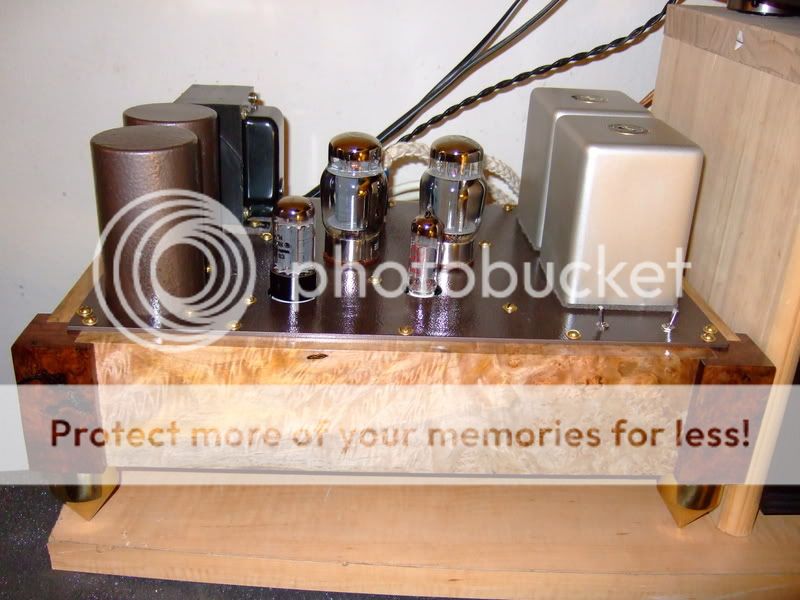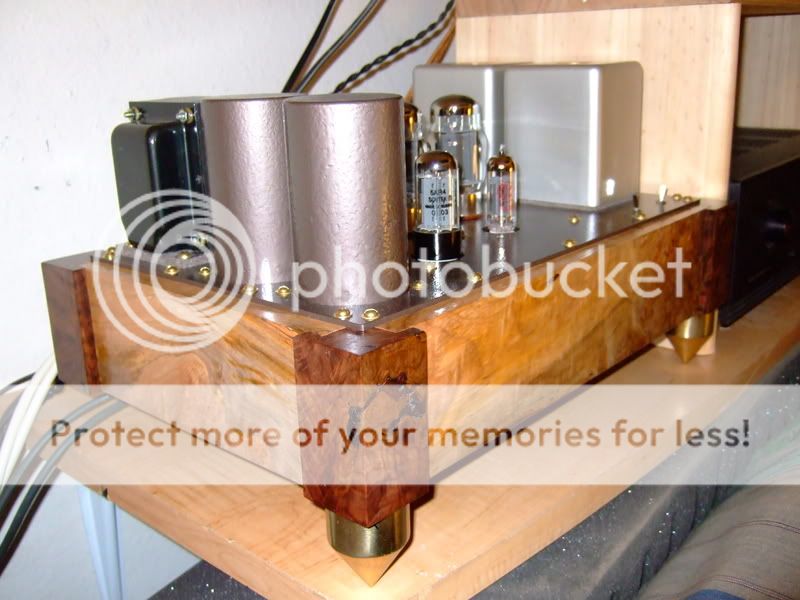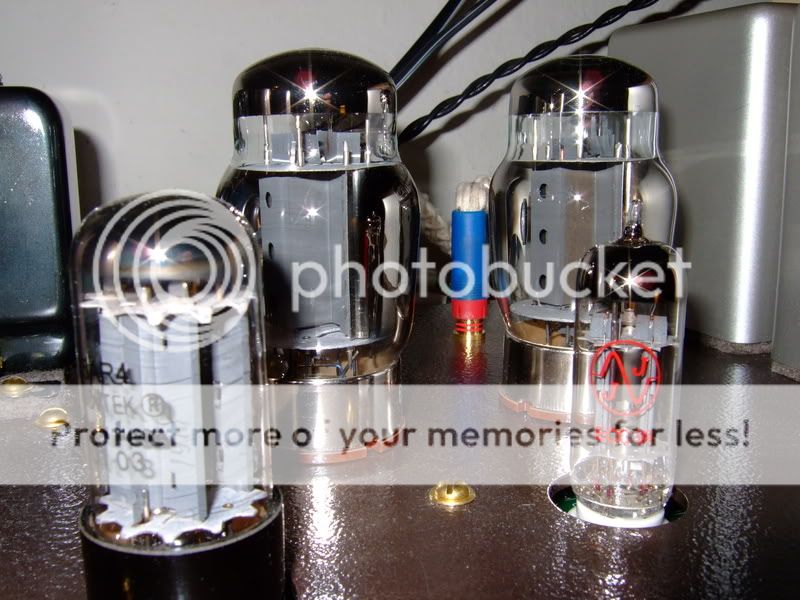Judging from the hint of redness in the plate of the left 6L6GC in your last picture it would seem that the power supply is working and the output tubes are drawing current. Put some speakers and a CD player (no, 8 track) on that thing and try it!
The outer metal sleve (the plate) on a tube shoudn't glow red. This indicates too much power is being dissipated in the tube. Measure your B+ voltage. Those Chinese 6L6GC's seem to be able to take this kind of abuse, but other tubes might not like it.
I have Radio Shack fuses in my amp. I bought all that they had at my local store, just in case. Harbor Freight meters, I got some of them too. Wait a minute, I got some of them from the store on 436 in Caselberry, same store?
The outer metal sleve (the plate) on a tube shoudn't glow red. This indicates too much power is being dissipated in the tube. Measure your B+ voltage. Those Chinese 6L6GC's seem to be able to take this kind of abuse, but other tubes might not like it.
I have Radio Shack fuses in my amp. I bought all that they had at my local store, just in case. Harbor Freight meters, I got some of them too. Wait a minute, I got some of them from the store on 436 in Caselberry, same store?
tubelab.com said:Judging from the hint of redness in the plate of the left 6L6GC in your last picture it would seem that the power supply is working and the output tubes are drawing current. Put some speakers and a CD player (no, 8 track) on that thing and try it!
The outer metal sleve (the plate) on a tube shoudn't glow red. This indicates too much power is being dissipated in the tube. Measure your B+ voltage. Those Chinese 6L6GC's seem to be able to take this kind of abuse, but other tubes might not like it.
Yes, the power supply is working. B+ reads 459 VDC. I just let the thing run with no input and no speakers for a while to make sure it stayed working. Everything got nice and warm. I was pretty happy at that point. I was tempted to hook up a cd player and try it out, but didn't want to rush the job and get sloppy somewhere. It can wait... I think.
Harbor Freight meters, I got some of them too. Wait a minute, I got some of them from the store on 436 in Caselberry, same store?
Exactly.
$3 for the basic model, $4 with a backlight. They don't seem quite as quick to settle on a reading as the Flukes at work (some big defense contractor), but they seem fine for 'roughly 460 volts / about 150 ohms' readings. I really do need to pick up another 'nice' meter... I pulled two out of the packaging and they read within 1% of each other. You can safely assume that I bought them after seeing them on your website.
Rick
I have a friend who lives down the street from that store, we went in there and they had some red colored meters for $4 each, so I got two more just because they were different. I have been known to hook up a lot of meters. Sometimes it helps if they don't all look the same.
460 volts with a tube rectifier is a bit high. What power transformer are you using? You would get 480 to 490 volts with the SS diodes, so their use may not be a good idea. This is too close to the 500 volt rating on the capacitors. Trust me an exploding electrolytic cap is not fun. I managed to blow one up about 2 hours ago and it still stinks in here!
After you get the amp running, measure the voltage across the 560 ohm cathode resistors. If it is too high the resistor value may need to be adjusted.
460 volts with a tube rectifier is a bit high. What power transformer are you using? You would get 480 to 490 volts with the SS diodes, so their use may not be a good idea. This is too close to the 500 volt rating on the capacitors. Trust me an exploding electrolytic cap is not fun. I managed to blow one up about 2 hours ago and it still stinks in here!
After you get the amp running, measure the voltage across the 560 ohm cathode resistors. If it is too high the resistor value may need to be adjusted.
Measuring several times:
The voltage across R1 is 21.4 VDC. That looks like 143 mA of current to me.
B+ measures closer to 470 VDC now. It's neat to watch the 5AR4 warm up and B+ climb over a few seconds.
R17 and R27 are at 35.4 and 35.6 VDC.
Red/Yellow to Red each measure about 396 VAC (375 VAC design target). Red-Red is 794 VAC.
My wall outlets are reading 121.1 VAC (118.6 VAC with the meter I rescued from the trash can).
The Chinese 6L6GC tubes are from AES. The tube vendor, not the ham radio shop.
Rick
The voltage across R1 is 21.4 VDC. That looks like 143 mA of current to me.
B+ measures closer to 470 VDC now. It's neat to watch the 5AR4 warm up and B+ climb over a few seconds.
R17 and R27 are at 35.4 and 35.6 VDC.
Red/Yellow to Red each measure about 396 VAC (375 VAC design target). Red-Red is 794 VAC.
My wall outlets are reading 121.1 VAC (118.6 VAC with the meter I rescued from the trash can).
The Chinese 6L6GC tubes are from AES. The tube vendor, not the ham radio shop.
Rick
That looks like 143 mA of current to me.
OK, 35.5 volts across a 560 ohm cathode resistor is about 63 mA per output tube. The 12AT7 gets about 10 mA per side so 63 + 63 +10 +10 = 146 mA. This adds up within the tolerance of the resistors.
Next, the small Edcor OPT's measure about 130 ohms of DC resistance, at 63 mA you will lose about 8 volts in the transformer giving you about 462 volts on the plate. You measure about 35 volts on the cathode so the tube sees about 427 volts. 427 volts times .063 amps = 26.9 watts of dissipation in the tube. The 6L6GC is rated for 25 watts maximum, so your tubes are running a little hot, hence the redness. I like to run these tubes at about 23 watts, expensive NOS 6L6GC's at about 20 watts, but some "new" 6L6 types can be run as hard as 30 watts without issue.
I'm not sure where you got the Chinese tubes, but I'm wondering if these aren't as reliable as George has seen with his....The Chinese 6L6GC tubes are from AES.
I got some from several sources including AES, Ebay and ESRC (in Orlando by the way). I haven't been able to blow up any of them yet, but they ARE inconsistent from lot to lot as to current draw. The pair that I use with the same Allied power transformer, Edcor OPT's, and 560 ohm cathode resistors run at 28 volts.
What do you do about the high tube dissipation? You increase the value of the cathode resistor. Raising the resistor value does two things. It increases the cathode voltage, which lowers the voltage seen by the tube, and it makes the grid (at 0 volts) more negative than the cathode (+35 volts), which reduces the tube current. Lower tube current increases tube life but also increases the distortion reduces the damping factor and may slightly reduce power output. I would raise the value of the cathode resistor to 620 ohms or even 680 ohms if needed.
You can follow the same method that I used above to determine the tube dissipation for any tube type. Compare that to the published maximum. The best tube life compromize in a SE amp is 70 to 80% of the published maximum. Sometimes better sound can be had by running the tube at 90% or more, but the tube life will decrease.
Hi, just got my Simple // SE working.
A note on the JJ rectifier tubes: they are shorting at an alarming rate. I had one cause some issues in a preamp, and another one just shorted in a friend's Simple // SE, causing the diodes to short. The Sovteks seem to be better, but they also fail frequently. There seems to be no better option than a used or NOS Mullard... lots more cash, but it seems to be the best option. Another friend is looking into getting some TAD 5ar4s, which are currently not available in the US.
I posted some pics and info in the pic thread that is stickied, I'll copy and paste here:




A note on the JJ rectifier tubes: they are shorting at an alarming rate. I had one cause some issues in a preamp, and another one just shorted in a friend's Simple // SE, causing the diodes to short. The Sovteks seem to be better, but they also fail frequently. There seems to be no better option than a used or NOS Mullard... lots more cash, but it seems to be the best option. Another friend is looking into getting some TAD 5ar4s, which are currently not available in the US.
I posted some pics and info in the pic thread that is stickied, I'll copy and paste here:
A few pics of the SimpleSE I just finished. It uses a ccs-loaded ecc99 driver tube and is a straight power amp. I don't think the ecc99 needs the CCS, but it was part of the circuit with the 12at7 so I thought I'd give it a try with CCS. I increased the current that the ccs supplies to just over 20 mA to better suit the ecc99 and left out the volume pot, other than that its a regular SimpleSE. It also has switches for cfb and ul operation. Some of the parts I used are Tung Sol 6550 power tubes, James OPTs, Electraprint custom choke, Riken, Kiwame and AN resistors, Mundorf SOI coupling caps and Vampire connectors. I wired it with mil spec silver plated teflon wire and Jupiter silver wire for the inputs.




Re: Re: Re: My first SE OPT
I've used the same Transcendar transformer as George (tubelab) and I've yet to encounter a better transformer at anywhere near the price. They are very good regardless of the price.
Ty_Bower said:
Gery (the eBay seller) will add a 50% UL tap to the Transcendars for a very reasonable fee. Just send him an email before you buy a set. The only downside is that he doesn't stock the tapped version, so it adds a couple weeks to his shipment time.
I've used the same Transcendar transformer as George (tubelab) and I've yet to encounter a better transformer at anywhere near the price. They are very good regardless of the price.
Davec113 said:Another friend is looking into getting some TAD 5ar4s, which are currently not available in the US.
N/M they are re-branded Chinese tubes. Apparently some TAD tubes are unique, but not the 5ar4.
I've had relatively good luck with Chinese 5AR4 particularly in comparison to more recent JJ production.
I usually stick a UF4007/1N4007 in series with each plate lead, this seems to end issues with arcing during warm up and other related issues. (I do this wherever I use 5AR4, whether vintage or current production.)
I have found in old ST-70 that it is quite possible to kill perfectly good Mullard and Telefunken 5AR4 if the power switch is bad or if the power is cycled before the 5AR4 has had some time to cool. The aforementioned diodes will generally prevent these outcomes while retaining the soft conduction characteristic and slow warm up of a tube rectifier.
I use mostly Mullards in my gear and luckily have quite a few acquired long ago for the personal stash in the aftermath of a number of failures in Chinese made 5AR4..
Great looking amplifier!
I usually stick a UF4007/1N4007 in series with each plate lead, this seems to end issues with arcing during warm up and other related issues. (I do this wherever I use 5AR4, whether vintage or current production.)
I have found in old ST-70 that it is quite possible to kill perfectly good Mullard and Telefunken 5AR4 if the power switch is bad or if the power is cycled before the 5AR4 has had some time to cool. The aforementioned diodes will generally prevent these outcomes while retaining the soft conduction characteristic and slow warm up of a tube rectifier.
I use mostly Mullards in my gear and luckily have quite a few acquired long ago for the personal stash in the aftermath of a number of failures in Chinese made 5AR4..
Great looking amplifier!
It makes sound! http://www.youtube.com/watch?v=d3EIPeFeSWY
Audio is very thin, but those little car speakers are playing in free-air and I have no idea about the req. response of my camera. I assure you, it sounds a little better in person. Really.
After thinking about the B+ voltage being a little high, I found a small autotransformer (aka Variac) at my favorite surplus electronics shop and dropped the input voltage just a bit (until B+ was a nice stable 430V). The heater voltages are reading 4.6 and 5.9 -- will that be a long-tem problem?
Prior to doing that, I also changed the cathode resistors to 680 ohms. I bought 5 ea. of 560, 620, 680, 750, 820 -- so I can tailor the power now. After seeing George show a little concern, I got conservative about things.
I'm still not happy about the rectifier situation, but with the ability to dial-in the voltage, I can use the SS section as a backup. Tested it with new hexfreds, and it works fine.
I need to start planning a real chassis now.
Rick
Audio is very thin, but those little car speakers are playing in free-air and I have no idea about the req. response of my camera. I assure you, it sounds a little better in person. Really.
After thinking about the B+ voltage being a little high, I found a small autotransformer (aka Variac) at my favorite surplus electronics shop and dropped the input voltage just a bit (until B+ was a nice stable 430V). The heater voltages are reading 4.6 and 5.9 -- will that be a long-tem problem?
Prior to doing that, I also changed the cathode resistors to 680 ohms. I bought 5 ea. of 560, 620, 680, 750, 820 -- so I can tailor the power now. After seeing George show a little concern, I got conservative about things.
I'm still not happy about the rectifier situation, but with the ability to dial-in the voltage, I can use the SS section as a backup. Tested it with new hexfreds, and it works fine.
I need to start planning a real chassis now.
Rick
rkevans said:It makes sound! http://www.youtube.com/watch?v=d3EIPeFeSWY
Audio is very thin, but those little car speakers are playing in free-air and I have no idea about the req. response of my camera. I assure you, it sounds a little better in person. Really.
After thinking about the B+ voltage being a little high, I found a small autotransformer (aka Variac) at my favorite surplus electronics shop and dropped the input voltage just a bit (until B+ was a nice stable 430V). The heater voltages are reading 4.6 and 5.9 -- will that be a long-tem problem?
Prior to doing that, I also changed the cathode resistors to 680 ohms. I bought 5 ea. of 560, 620, 680, 750, 820 -- so I can tailor the power now. After seeing George show a little concern, I got conservative about things.
I'm still not happy about the rectifier situation, but with the ability to dial-in the voltage, I can use the SS section as a backup. Tested it with new hexfreds, and it works fine.
I need to start planning a real chassis now.
Rick
I would just work on dropping the B+ directly, dealing with a variac from now until eternity could be a nuisance. The filament voltages are kind of low, and for power tubes I like to run them as close as possible to rated voltage for best life..
You can add some resistance (small power resistor) in the center tap, change to a 5R4 rectifier tube (caveat emptor - rather fast warm up time compared to 5AR4 - watch out that the voltage does not exceed the rating of your supply caps before the output tubes start to draw appreciable current) reduce the value of the input capacitor (may get noisy) or get a choke with somewhat higher dcr..
You could also go to a choke input supply with a small "tuning" cap at the front end to bring the voltage up to your target value. (The "tuning" cap will typically be just a few uF - and could be a high voltage film. You just iterate the value until you get the right voltage at the output. The choke must be designed for this sort of use or it will buzz excessively, and you should use a 5AR4 because the slow warm up will assure that excessive voltages don't appear at the output before the output tubes warm up.)
- Status
- This old topic is closed. If you want to reopen this topic, contact a moderator using the "Report Post" button.
- Home
- More Vendors...
- Tubelab
- Photo Gallery -- Simple SE build